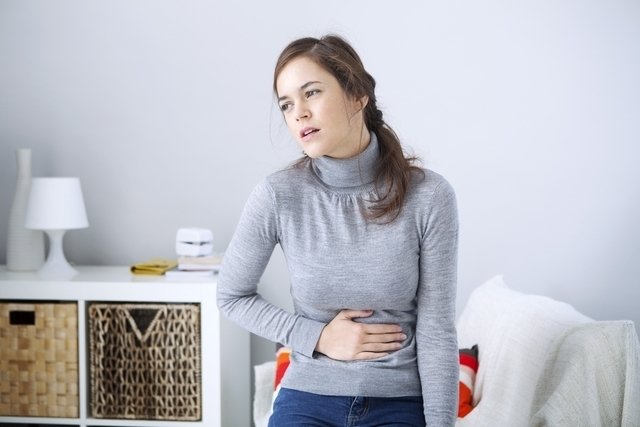Appendicitis is a condition characterized by inflammation of a part of the intestine, the appendix, which is located in the lower right region of the abdomen.
The most common symptoms of appendicitis are pain in the lower right side of the belly, nausea and vomiting, loss of appetite, persistent low-grade fever, constipation or diarrhea, swollen belly, and reduced or absent intestinal gas, which resemble other conditions. In all cases where these symptoms appear, you should go to a medical emergency room as soon as possible, in order to avoid complications.
Appendicitis is easier to diagnose in men, because in women the symptoms can be confused with other gynecological situations, such as pelvic inflammatory disease, torsion of the ovaries or ectopic pregnancy, for example, which occurs due to the proximity that the appendix has in relation to the female reproductive organs.

Some of the conditions and diseases that can be confused with appendicitis are:
1. Intestinal obstruction
Intestinal obstruction is characterized by interference in the intestine caused by the presence of intestinal obstructions, tumors or inflammation, which makes it difficult for feces to pass through the intestine. Find out what the causes of intestinal obstruction are.
Symptoms that may arise in this situation include difficulty passing or eliminating gas, bloating, nausea or abdominal pain, which are very similar to appendicitis. If these symptoms appear, it is very important to seek medical assistance as soon as possible.
2. Inflammatory bowel disease
Inflammatory bowel disease refers to Crohn’s disease and ulcerative colitis, which are characterized by inflammation of the intestine, leading to symptoms very similar to those of appendicitis, such as abdominal pain, diarrhea and fever.
However, in some cases, weight loss, anemia or food intolerances may also be seen, which may help to exclude the possibility of appendicitis.
If any of these symptoms are present, you should go to the emergency room as soon as possible. Learn more about inflammatory bowel disease.
3. Acute diverticulitis
Acute diverticulitis is a condition characterized by inflammation and infection of the intestinal diverticula, whose symptoms are exactly the same as those that occur in appendicitis, such as abdominal pain, diarrhea or constipation, tenderness on the left side of the abdomen, nausea and vomiting, fever and chills, the intensity of which can vary depending on the severity of the inflammation.
If it is not treated quickly, complications may occur, such as bleeding, abscesses, perforation or intestinal obstruction, so as soon as the first symptoms appear, you should go to the emergency room immediately. Find out how diverticulitis is treated.
4. Pelvic inflammatory disease
Pelvic inflammatory disease is characterized by an infection that starts in the vagina and spreads to the uterus, tubes and ovaries, and in some cases can spread to the abdomen, and should therefore be treated as soon as possible. Learn more about pelvic inflammatory disease.
This disease occurs in women and is more common in sexually active young women who have several sexual partners without using protection.
Some of the symptoms can be confused with appendicitis, however, in this case, vaginal bleeding may also occur outside of the menstrual period or after sexual intercourse, foul-smelling vaginal discharge and pain during intimate contact, which helps to exclude the possibility of appendicitis. .
5. Constipation
Constipation, especially that which lasts for many days, can cause symptoms such as difficulty and straining to evacuate, abdominal pain and discomfort, belly swelling and excess gas, however, generally the person does not have a fever or vomiting, which can help to exclude the possibility of appendicitis.
6. Kidney stones
When a kidney stone appears, the pain can be very intense and, as with appendicitis, vomiting and fever may also appear, however, the pain caused by the kidney stone is generally located in the lower back and is not felt. both in the abdomen, which helps to exclude the possibility of appendicitis.
In addition, other symptoms that may appear are pain when urinating, pain that radiates to the groin and red or brown urine. Learn about other kidney stone symptoms.
7. Torsion of the ovaries
Torsion of the ovaries occurs when the thin ligament that attaches the ovaries to the abdominal wall bends or twists, causing intense pain, due to the presence of blood vessels and nerves in the region, which become compressed. If the torsion occurs on the right side, the person may mistake it for appendicitis, however, in most cases, no other characteristic symptoms appear.
Treatment for ovarian torsion should be done as soon as possible and generally consists of surgery.
8. Ectopic pregnancy
Ectopic pregnancy consists of a pregnancy that develops in the uterine tube, and not in the uterus, causing symptoms such as intense abdominal pain, only on one side of the belly and a swollen abdomen. Furthermore, it can cause vaginal bleeding and a feeling of heaviness in the vagina, which makes it easier to diagnose. Learn how to identify the symptoms of an ectopic pregnancy.

Sign up for our newsletter and stay up to date with exclusive news
that can transform your routine!
Warning: Undefined array key "title" in /home/storelat/public_html/wp-content/plugins/link-whisper-premium/templates/frontend/related-posts.php on line 12
Warning: Undefined array key "title_tag" in /home/storelat/public_html/wp-content/plugins/link-whisper-premium/templates/frontend/related-posts.php on line 13




